N.Y. subway construction blast goes awry; work halted
- Share via
Work on New York City’s oft-delayed Second Avenue subway line -- which was conceived decades ago to help commuters living on Manhattan’s eastern edge -- was on hold Wednesday as investigators tried to determine why a construction blast went awry and sent debris and smoke raining over the neighborhood.
Nobody was injured in the blast Tuesday afternoon, but area residents described feeling as if they were under attack as buildings shook and a giant smoke cloud rose from the ground. “I just went and hit the floor, covered my head, waiting for another blast or something,” Susan Schuander, who was in a nearby shop, told reporters. “I was trembling.”
Officials of the city’s Metropolitan Transportation Authority said workers set off what was supposed to be a controlled detonation to clear space for an escalator that will be part of the subway line. The first phase is due for completion in December 2016 and three more phases will follow. But the detonation was anything but controlled.
“It happened and we do not know why at this point,” the MTA’s president of capital construction, Michael Horodniceanu, said at the scene, at the corner of 72nd Street and 2nd Avenue on Manhattan’s Upper East Side.
The MTA chairman, Joseph Lhota, expressed anger over the incident, which was sure to elevate some area residents’ concerns over safety and other issues surrounding the massive construction project, the first substantial subway extension in more than 50 years.
“I fully understand why neighbors of the construction site are upset. I am, too,” he said, vowing to work “with the community to ensure their concerns are heard and acted upon.”
The new subway line eventually will stretch more than eight miles, from East 63rd Street in Manhattan to Harlem, and will include 16 stations. According to the MTA, the new line would serve hundreds of thousands of riders daily and sharply cut commuting times for people living on the East Side, which currently is served only by the Lexington Avenue line.
But from the start, the project -- first proposed in the 1920s -- has been plagued by delays, most of them rooted in economics, from the Great Depression to the city’s money woes in the 1970s. A groundbreaking finally took place in 2007. Since then, some area residents have complained that dust and fumes from the $4.5-billion project are fouling their air. A study released this year by the MTA disputed those claims and said blasting operations were not releasing enough elements into the air to create health problems.
ALSO:
A storm is brewing around the GOP convention -- for real
Texas can cut Planned Parenthood clinic funding, judges rule
Washington state: Possible radioactive leak at Hanford tank farm
More to Read
Sign up for Essential California
The most important California stories and recommendations in your inbox every morning.
You may occasionally receive promotional content from the Los Angeles Times.














